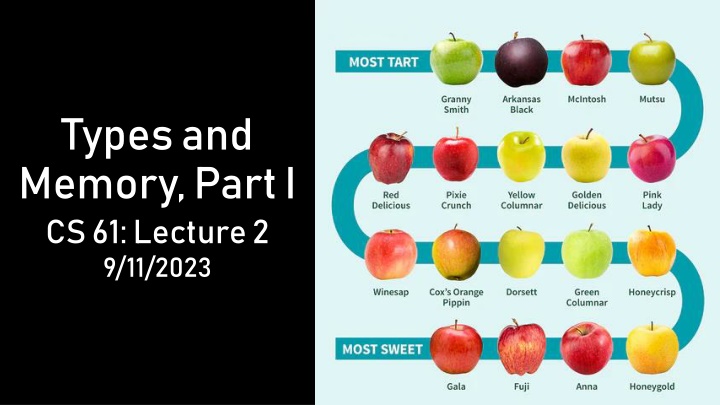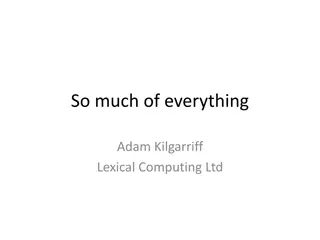
Types and Memory Management in Operating Systems
Explore how user-level processes interact with hardware through the operating system using system calls. Learn about memory management, CPU execution, and hardware features like MMU and timer. Dive into the flow of processes in a computer system via insightful lectures.
Download Presentation

Please find below an Image/Link to download the presentation.
The content on the website is provided AS IS for your information and personal use only. It may not be sold, licensed, or shared on other websites without obtaining consent from the author. If you encounter any issues during the download, it is possible that the publisher has removed the file from their server.
You are allowed to download the files provided on this website for personal or commercial use, subject to the condition that they are used lawfully. All files are the property of their respective owners.
The content on the website is provided AS IS for your information and personal use only. It may not be sold, licensed, or shared on other websites without obtaining consent from the author.
E N D
Presentation Transcript
Types and Memory, Part I CS 61: Lecture 2 9/11/2023
Recap of Lecture 1 User-level processes interact with each other and the hardware via the operating system in particular, via system calls system calls User-level process X User-level process Y User-level process Z //Process X wants to read 32 bytes of data //from a file that is stored on the SSD. //First, get a file descriptor that allows //the process to interact with the file. int fd = open( file.txt , O_RDONLY); Operating system (Kernel-level code) MMU MMU MMU MMU Hardware RAM SSD UX devices Network
Recap of Lecture 1 User-level processes interact with each other and the hardware via the operating system in particular, via system calls system calls User-level process X User-level process Y User-level process Z //Process X wants to read 32 bytes of data //from a file that is stored on the SSD. //First, get a file descriptor that allows //the process to interact with the file. int fd = open( file.txt , O_RDONLY); Operating system (Kernel-level code) //Declare an array to hold the file data. char buf[32]; MMU MMU MMU MMU //Read the file data into the array! ssize_t bytes_read = read(fd, buf, sizeof(buf)); Hardware RAM SSD UX devices Network
Recap of Lecture 1 User-level processes interact with each other and the hardware via the operating system in particular, via system calls system calls A process contains in-memory state like: Program variables (e.g., global variables and local variables) Function code At any given moment, a particular CPU executes code from a single entity (either a user-level process or the OS) The OS leverages various hardware features to maintain order on the computer MMU (memory management unit): OS configures it so that, when a process executes, it can only touch the memory belonging to that process Timer hardware: Ensures that the OS will eventually get to run even if a process loops forever User-level process X User-level process Y User-level process Z Operating system (Kernel-level code) MMU MMU MMU MMU Hardware RAM SSD UX devices Network
Recap of Lecture 1 User-level processes interact with each other and the hardware via the operating system in particular, via system calls system calls A process contains in-memory state like: Program variables (e.g., global variables and local variables) Function code At any given moment, a particular CPU executes code from a single entity (either a user-level process or the OS) The OS leverages various hardware features to maintain order on the computer MMU (memory management unit): OS configures it so that, when a process executes, it can only touch the memory belonging to that process Timer hardware: Ensures that the OS will eventually get to run even if a process loops forever User User Kernel Kernel User interrupt schedule schedule timer syscall (1) (2) (3) (4) Flow of time from the perspective of the leftmost CPU MMU MMU MMU MMU Hardware RAM SSD UX devices Network
Todays Lecture: Data Types and Memory In a C++ program: What types of data values can be stored in memory? For each type, what kinds of operations does C++ support? How is the memory space of a process organized? Where does code live? Where does data live, and how long does it live? User-level process X User-level process Y User-level process Z Operating system (Kernel-level code) MMU MMU MMU MMU Hardware RAM SSD UX devices Network
Primitive Types in C++ A type type describes two things A set of possible values A set of allowable operations allowable operations on those values A primitive type primitive type is one that is not composed of other types Different programming languages define different primitive types! In C++, there are primitive types for: Integers (e.g., 57, -9123, 0, with arithmetic, comparison, and bitwise operations) Floating-point numbers (e.g., 61.925, INFINITY, NAN, with arithmetic and comparison operations) Booleans (i.e., true, false, with comparison operations (==, !=)) Pointers (i.e., the memory locations of other values, with limited arithmetic operations (addition, subtraction, comparison)) values Arithmetic: +, -, *, /, % Comparison: <, <=, ==, >=, >,!= Bitwise: ~, &, |, ^, <<, >>
Primitive Types in C++ type describes two things A set of possible values values A set of allowable operations allowable operations on those values A primitive type primitive type is one that is not composed of other types Different programming languages define different primitive types! In C++, there are primitive types for: Integers (e.g., 57, -9123, 0, with arithmetic, comparison, and bitwise operations) Floating-point numbers (e.g., 61.925, INFINITY, NAN, with arithmetic and comparison operations) Booleans (i.e., true, false, with comparison operations (==, !=)) Pointers (i.e., the memory locations of other values, with limited arithmetic operations (addition, subtraction, comparison)) A type int id = 999; int* ptr = &id; //ptr contains the //memory address //of the variable id
Values in C++ CPU instructions manipulate bits stored in registers and memory 8 bits is called a byte An x-bit CPU has registers that are x bits in size, e.g., a 64-bit Intel CPU has registers that are 64 bits (i.e., 8 bytes) large % %rcx rcx % %rdx rdx bits (zeroes and ones) that are A (simplified!) view of an x86 CPU and RAM RAM byte Registers Byte N-1 % %rax rax % %rbx rbx . . . CPU RAM controller ALU Instruction decode ALU op ALU output Byte 0 RAM controller command
Values in C++ CPU instructions manipulate bits stored in registers and memory 8 bits is called a byte An x-bit CPU has registers that are x bits in size, e.g., a 64-bit Intel CPU has registers that are 64 bits (i.e., 8 bytes) large A bit pattern can be represented in various ways Consider this 16-bit (i.e., 2 byte) pattern . . . bits (zeroes and ones) that are byte Raw bits: 01100111 11000011 Hex: 67C3 Decimal: 26563 the apostrophe does not exist in the actual binary representation do not waste time trying to find it
Values in C++ Recall that: C++ programs execute on an abstract machine which defines stuff like: A memory model Valid data types Control flow operations (e.g., if-else) The compiler translates a program s manipulation of the abstract machine to actual CPU instructions that can execute on real hardware The C++ standard defines minimum sizes for integer data types, but allows a compiler to represent them using more bits (as appropriate for a particular CPU)
Values in C++ Different types have different rules for interpreting the bits in a value So, the same set of bits mean different things when interpreted as different types! This means that you cannot tell the type of a value just by the type of a value just by looking at its bit values looking at its bit values! //On x86-64, all of these //values have the same size //and the same bit-level //representation! int a1 = 1; unsigned char a2[] = {1,0,0,0}; unsigned short a3[] = {1,0}; unsigned a4 = 1; float a5 = 1.4013e-45; you cannot tell
The sizeof sizeof() () operator in C++ The C++ operator sizeof(x) allows a program to retrieve the size in bytes of the value belonging to x (as defined by x s type) Ex: int x = 42; printf( %d\n , sizeof(x)); Ex: printf( %d\n , sizeof(int)); //i.e., you can also //pass a type name to sizeof() For example, on a Linux x86-64 machine: sizeof(char): 1 sizeof(unsigned char): 1 sizeof(short): 2 sizeof(unsighed short): 2 sizeof(int): 4 sizeof(unsigned int): 4 sizeof(long): 8 sizeof(unsigned long): 8 sizeof(float): 4 sizeof(double): 8
Objects in C++ value stored in one or more one or more adjacent memory locations adjacent memory locations Values like 42 or false are Platonic: they exist in the spirit world and can never change However, an object might contain different values over time int x = 0; //x is an object living //somewhere in memory; //the object s current //value is 0. x = 42; //The memory location //belonging to object x //now stores the value 42. A computer uses RAM ( random access memory ) hardware to store objects A modern laptop or desktop has ~8GB 32GB of RAM An iPhone 14 has 6GB of RAM A datacenter server has ~16GB 1TB of RAM An object object is a value Logical view of memory Actual physical RAM Byte N-1 We ll talk about the mapping in a few weeks! . . . Stores the binary representation of the value 0 42 Byte 0
(5) Via the terminal shell or a graphical interface, the user requests the launching of a new instance of the executable Lifecycle of a Process > > bsort bsort in.txt in.txt SSD (6) The shell or GUI uses system calls to: Create a new process Read the code and static data from the on-disk executable; place that information into the memory region that belongs to the new process Have the new process start running the loaded code! //Pseudocode to sort an array //of length n. bubblesort(arr, n): for(i=0; i<(n-1); i++): for(j=0; j<(n-i-1); j++): if(arr[j] > arr[j+1]): tmp = arr[j]; arr[j] = arr[j+1]; arr[j+1] = tmp; (1) Design the program (4) The binary ( executable ) arrives on a user s storage device (e.g., via an Internet download, a USB stick, or a local compilation) .cc .hh (3) Compile the program (2) Translate design to code
//C++ variables declared outside of //a function are globals (i.e., //visible to any function). They //have a static duration---they //are created when the program //launches and destroyed when the //program exits. int g = 42; //Initial value is 42. Address space Stores info about active functions (e.g., the values of local variables) Byte N-1 Stack void increment(bool do_print) { bool is_even; //This variable is a //local variable: it s created //when the enclosing function //starts, is only visible to //that function, and dies when //the function returns. g++; is_even = ((g % 2)==0); if (do_print) { printf( %d\t , g); printf( even: %s\n , is_even ? true : false ); } } Pulled from executable into RAM during (6) Static data Code int main() { increment(true); //Prints 43 false increment(true); //Prints 44 true return 0; } Byte 0 SSD
OK . . . but what if you can t predict how many variables your program will need? Ex: Your audio mixing program cannot predict how long a new track will be Ex: Your ML program reads training data from a live stream and you don t know the stream length a priori
Dynamic memory allocation to the rescue! Instead of determining how many variables you need at program development time . . . void f() { int x, y; //f always gets . . . allocate the needed amount of memory at program execution time: //two ints void f() { int n = read_int_from_user(); int* data = new int[n]; for (int i = 0; i < n; i++) { But where does this data live in the address space? do_stuff(data[i]);
The Heap Address space Dynamically-allocated memory lives in a program region known as the heap A programmer must explicitly and deallocate heap memory int* ptr = new int; //Allocation; //the new int //lives here do_stuff(ptr); delete ptr; //Deallocation In contrast: The compiler and program loader automatically automatically allocate memory space for static data The compiler automatically automatically emits machine instructions to allocate and deallocate memory space for stack variables we ll see this in a few lectures! Byte N-1 explicitly allocate Stack Pulled from executable into RAM during (6) Heap Static data Code Byte 0 SSD
Real-life Example of an Address Space Address space Byte N-1 #include <cstdio> int main(){ int x = 42; //Local variable in function int* ptr = new int[64]; //ptr is a local variable //whose value is the address //(i.e., starting memory //location) of the array //of ints in the heap printf( &x: %p\n , &x); //0x0000 7ffd d608 f94c printf( &ptr: %p\n , &ptr); //0x0000 7ffd d608 f940 printf( ptr: %p\n , ptr); //0x0000 0000 0185 22b0 printf( main: %p\n , main); //0x0000 0000 0040 1136 return 0; } Stack Heap Static data Code Byte 0






















